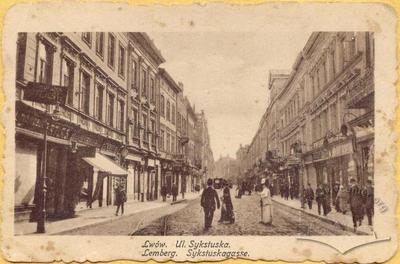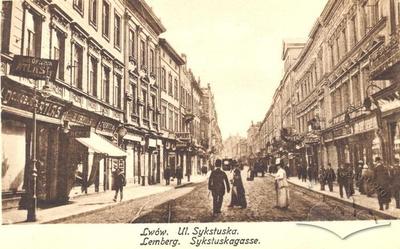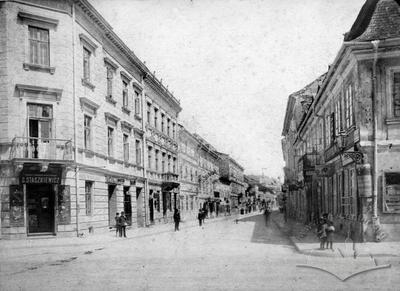
Vul. Doroshenka ID: 212
Petra Doroshenka Street lies between Svobody Boulevard and Bandery Street. Its previous names were: Sykstuska (or Sixtuska Gasse up to 1938), Obrony Lwowa (1938-1940), Sykstusstrasse (1941-1944), and Zhovtneva (1940, 1944-1992). This street arose in place of a road that once led from the medieval city walls to the estate of Erasm Sikst/Erazm Sykst, mayor of Lviv in the early seventeenth century and famous medical doctor. In the early twentieth century, the Historicist rental houses were partly replaced by Jugendstil buildings, and later Constructivist ones. 1894 saw an electric tram line being laid in the lower part of the street, leading from the Central Train Station to the Hetmanski Bulwarks, where it forked, leading to the Galician County Fair in Sofijówka, and through the Rynok Square to Lychakiv/Łyczaków. In November 1918 bitter fighting went on for the building of the Main Post Office between Ukrainian and Polish troops.
Story
Petra Doroshenka Street lies between Svobody Boulevard and Bandery Street. This street arose in place of a road that once led from medieval city walls to the estate of Erasm Sixt (Erazm Sykst), mayor of Lviv in the early seventeenth century and a famous doctor, described the mineral water sources in Shklo, and their medicinal properties in a book, published in Zamość in 1617. Sykst's estate stood on a hill not far from where today the stone Mary Magdalene Cathedral stands.The road that led to Sykst's estate was known as Sykstuska since his times, and also delineated the boundary between the Sykst family estate and the estate of Stanzl Scholtz/Szolc. Sykstuska St. was steeper than the parallel Sokilnytska Road (now Kopernyka Street), which is why it had less traffic and was less densely constructed. The even-numbered side of the street was adjacent to the Jesuit Garden (Ogród Jezuicki), the opposite side – to the estates and parks belonging to wealthy families of, among others, Kyiv and Riga voyevods, Counts Czartoryski, who in 1792 hosted Tadeusz Kościuszko, the hero of the Polish anti-Russian uprising. Between what are today Doroshenka and Sichovykh Striltsiv («Sich Sharpshooters») streets, there once were ponds, belonging to the Roman Catholic Archbishops of Lviv. Live carp were brought here from ponds by the town of Dunayiv so that the clergymen could always have fresh fish on their tables.In 1894 an electric tram line was laid through the bottom part of Sykstuska St., leading from the Central Train Station to the Hetmanski Bulwarks, where it forked to the Galician County Fair in Zofijówka, while the other branch passed through the Rynok Square and proceeded to Lychakiv/Łyczaków. The line was initially to go up the Sykstuska Road, however the slope was too steep, which is why the tracks were laid through Kopernyka and Slovatskoho Streets. In 2004 a thoroughfare for trams was built by the Markiyan Shashkevych monument with a large covered station. The tram tracks were laid on top of concrete blocks with rubber inlays and the sidewalks were somewhat broadened.
Behind house No. 10/12 a large courtyard can be found. It is unfortunately closed to the general public at the moment, however it displays remains of a household from the second half of the nineteenth century with a single-storery hut. A pomological garden, belonging to a certan Majer, once existed here, and this area was named Majerówka. Having sold his land for new construction in 1841, Majer moved to Pasiky Lychakivski («Lychakiv Bee Gardens»), again giving his name to the area, which was since known as Majerówka/Majorówka in Polish, or Mayorivka in Ukrainian.
Building No. 77, which opens into Markiyan Shashkevych Sq. was once home to the Lviv architect Tadeusz Obmiński (1874-1932).
November 1918 witnessed hard fighting between Ukrainian and Polish troops for the building of the Main Post Office. As a result of the fighting, the building burned down and suffered ruin.
Before World War Two, Sykstuska Street was home to several publishing houses and editors' offices for a number of newspapers and magazines. The Wiadomości Gminne (County News), Gazeta kościelna (Church Gazette) and Głos prawa (Voice of the Law) papers, as well as the Wschód (East) and Zorza nowa (New Star) magazines were published here. Building No. 21 housed the People's Cooperative Publishers.
The street also held several printing presses. The largest of these, in No. 33, belonged to Ignacy Jäger. In the Spring of 1939 the printing press was bought by the Ossolineum Foundation, which had planned to transfer equipment from its old printing press in Stefanyka Street to this location. However, World War Two erupted soon thereafter putting a stop to this project. The printing press in Doroshenka St. was liquidated, while in Stefanyka Street the Lviv Book Factory was founded.
Building No. 37 housed the editors' offices of the «Wschód» (East) magazine, as well as the Maksym Coffeehouse, also known as the Samuel Menasches Tavern. This building also held offices of the Cunard Line and White Star Line shipping companies, which provided travel to America for Galician emigrants.
Sykstuska was also the lawyers' street. About fifty lawyers, mostly Jewish, had their offices here.
Building No. 48 displays a cast-iron plague with the inscription «On June 22, 1941, Ukrainian Communist writers Oleksandr Havryliuk and Stepan Tudor were killed by a Nazi bombshell by this house».
The neighboring typical three-storey rental house No. 52 was home to the last pre-war President (Mayor) of Lviv, Stanisław Ostrowski (1892–1982).
A memorial plague on Building No. 50 reads: «In 1941-1943 this house was home to the legendary OUN Scout Marta Chorna-Medeya, who tragically perished in a crossfire with Gestapo officers on May 23, 1943.» The bronze plague established in 2003 was cast by Roman Romanovych.
Previous names:
up to 1938. – Sixtuska Gasse, Sykstuska.
1938-1940 – Obrony Lwowa («Defense of Lviv/Lwów»). This name was given to the part of Sykstuska above the Main Post Office in 1938 in honor of the twentieth anniversary of November fights.
1940, 1944-1992 – Zhovtneva («October»).
1941-1944 pp. – Sykstusstrasse
1992 onwards – Doroshenka. The deputies of the first democratically elected City Council named the street in honor of Hetman Petro Doroshenko, whose army, together with Turkish troops, attempted to take Lviv in 1672.
Architecture
Building No. 11 (1898, based on the project by architect Karol Boublik.one of the earliest Secession buildings in Lviv under No. 9, was constructed after a project by Alfred Zacharevych in 1899-190.
the gate of Building No. 6 began the former Hausman Passage (Pasaż Hausmanna), now known as Kryva Lypa («Crooked Linden») passage.
the building of the Main Post Office, constructed in 1886-1889 based on a project by Sylwester Hawryszkiewicz and Franz Setz.
the new buildings of the Greek Catholic Spiritual Seminary under No. 41, constructed in 1889 after a project by Sylwester Hawryszkiewicz.
building in 15 Doroshenka St. was built in 1906-1907, based on a project by Zygmunt Kędzierski and Michał Ulam; some publications provide Tadeusz Obmiński as architect. The building's first floor housed the popular Sanssouci Coffeehouse.
Building No. 19 was constructed in 1909 in Neo-Baroque style, following a project by Włodzimierz Podhorodecki for banker Edward Landau.
The corner of Doroshenka (No. 20) and Kostiushka (No. 1). Streets holds the Jugendstil building of a former Hotel, the Narodna Hostynnytsia («People's Hotel»). It was constructed in 1904-1906, based on a project by Tadeusz Obmiński.
Building No. 37 (constructed in 1892-1894, based on a project by Jan Tomasz Kudelski for liquor manufacturer Leopold Baczewski), held the editors' offices of the Wschód (East) magazine, as well as the Maksym Coffeehouse, known also as the Samuel Menasches tavern. Offices of the Cunard Line and White Star Line companies, which provided travel to America for Galician emigrants, were also located here. Zygmunt Gorgolewski (1845–1903), architect of the Lviv City Theater (now Opera Theater), lived in this building until his death.
No. 47 not far from the Greek Catholic Seminary was home to the Taras Shevchenko girls' school
the Seniawskis and Baworowskis arsenal and library by the Mary Magdalene Cathedral (2 Bibliotechna St.)
villa under No. 73
The first constructivist building was the telephone station of the Polish Stock Telephone Company, constructed in 1926 after a project by Yevhen Chervynskyi.
Related buildings and spaces
Sources
- V. Vuitsyk, «Terytorialnyi rozvytok mista Lvova (do 1939 roku) // Visnyk instytutu «Ukrzakhidproektrestavratsiya», No. 8, Lviv 1997, pp. 41-48.
- Entsyklopediya Lvova, vol. 1/ Za red. A. Kozytskoho ta I. Pidkovy, Lviv: Litopys 2007 (656 pages)
- B. Melnyk, Dovidnyk pereymenuvan vulyts i plosch Lvova. XIII-XX stolittia, Lviv: Svit, 2001, p. 20.
- R. Mohytych, «Peredmistia Samovriadnoho Lvova u pershii polovyni XVII stolittia» // Visnyk instytutu «Ukrzakhidproektrestavratsiya», No. 13. – Lviv 2003, pp. 33-51.
- I. Siomochkin, «Nevidomi tvory Petra Viytovycha na odnii z lvivskykh kamianyts» // Visnyk instytutu «Ukrzakhidproektrestavratsiya», No. 8, Lviv 1997, pp. 114-117.
- Architektura Lwowa XIX wieku, Kraków 1997, (92 pages, illustrated)
- Ludwik Finkel, Historia Uniwersytetu Lwowskiego do 1869 roku, Lwów 1894, 346 s.
- Lwów, Ilustrowany przewodnik, Lwów: Centrum Europy, 2003 (320 pages)
- Skorowidz król. stol. miasta Lwowa, Lwów 1916 (256 pages)




